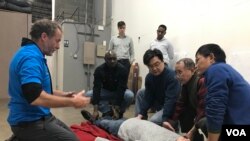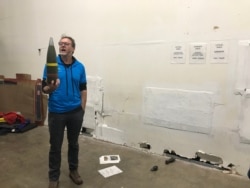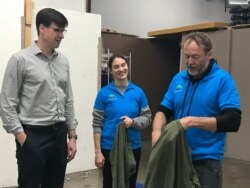WASHINGTON - "Grenade!"
I took off for the door. Three steps and I dove for the ground.
This was the wrong answer.
"Don't run, guys! You're not going to outrun a grenade."
I and a dozen other VOA journalists got up and dusted ourselves off. It was day one of a three-day hazardous environment training workshop and I think our instructor was disappointed.
Shane Bell with training firm GJS had just told us that the first thing you do when someone yells "grenade" is hit the floor. Close your legs with your heels sticking up. It's better to get shrapnel in your soles than your groin, he helpfully pointed out. Open your mouth so the blast wave doesn't pulverize your insides.
You get the sense that Bell knows this because someone threw a grenade at him once. Probably more than once. He's a former Australian commando. Now he does security for journalists. He's helped keep reporters from getting killed or kidnapped in Syria, Iraq, Ukraine and elsewhere. He's protected NGOs dealing with disasters and crises around the world. He peppered his talks with harrowing stories from his career that make you wonder how he sleeps at night.
I'm a science journalist. To be honest, I had no reason to be here. But VOA got a group discount and they had room for one more.
It sounded like fun. It was fun.
It was also terrifying.
Those stories of crisis-moment heroism? Based on the past three days, I'm pretty sure that's not me. I don't think it's most of us. Which makes those moments of heroism all the more remarkable.
The capacity for rational thought is what makes us human. It evolved on top of preexisting brain structures that control emotions and basic bodily functions. But evolution seems to have decided that the older parts have gotten us this far and should be in charge in an emergency.
Rational thought is the first thing that goes out the window.
We went through drills where we were interrogated, grabbed by hostile mobs and shot at. We did first-aid drills for stabbings, shootings and car crashes.
We knew they were drills. We knew the interrogators, the shouting demonstrators and the bodies lying around the scenes were actors.
But when the smoke hit my nostrils in the car-crash drill, I didn't go into superhero mode. I dropped the ball.
I found my colleague bandaging up a woman with a bloody compound fracture on her leg. Since he had that in hand, I started on another step from our first-aid training: checking her head-to-toe for other injuries. I was about halfway through when another colleague called for help with his patient. I got up to see what I could do.
Someone else got to the other patient before me. I could have gone back to finish the head-to-toe check. I don't remember what I did, but that wasn't it.
In the debrief, we found out she had a gaping wound on her other leg. I had left it untreated. What would have happened to her if that were real?
That exercise was stressful, but over the course of the training I learned that many of my colleagues have already been through worse. Many of them had stories that gave me a newfound respect for the work they do.
A colleague from VOA English to Africa had been kidnapped in the Democratic Republic of Congo by child soldiers, who stripped him down and put a gun to his head. What finally placated them was a pack of cigarettes.
Cigarettes are, in fact, an excellent medium of exchange in many hostile areas, Bell said. A big bag of packs of cigarettes was part of the essential gear in a drill on getting through checkpoints.
Several VOA Mandarin service colleagues were just back from covering the increasingly violent protests in Hong Kong. One had a Molotov cocktail land at his feet. Had it burst as intended, he would have been engulfed in flames.
Bell's sartorial suggestions for demonstration wear: natural fibers. In a fire, synthetics will melt onto your skin.
A Mandarin service reporter said an Indonesian video journalist had lost an eye to a rubber bullet. That was a brutal object lesson for something we learned later in a section on personal safety: Photographers, get your shots from outside the line of fire.
Hazardous environment training aims to help you put your rational brain back in the driver's seat in a crisis. My colleagues said they feel better prepared for the next time they're in harm's way.
Now more than ever, I have tremendous respect for them. As for me, my rational brain tells me that I am not cut out for being in harm's way. I think I'll stick to science.








